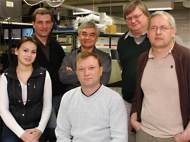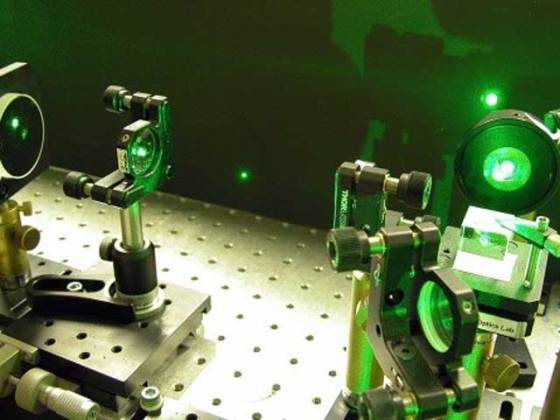Laser beams used to contain and move tiny objects
 Although it’s been years since optical tweezers have been used to move particles, the previous methods weren’t able to move them on distances larger than few millimeters. Researchers at the Australian National University (ANU) made a breakthrough by developing a method which can move objects much further by using laser beams. The researches have managed to move objects at a much larger distance of a meter and a half (almost 5 feet).
Although it’s been years since optical tweezers have been used to move particles, the previous methods weren’t able to move them on distances larger than few millimeters. Researchers at the Australian National University (ANU) made a breakthrough by developing a method which can move objects much further by using laser beams. The researches have managed to move objects at a much larger distance of a meter and a half (almost 5 feet).
According to team leader Professor Andrei Rode, his team from the Laser Physics Centre at ANU used a hollow laser beam to trap light-absorbing particles in a “dark core”. The device works by shining its beam around tiny glass particles. The hollow laser beam heats up the air surrounding the particles, but the dark center of the beam is directed toward them which allows the particles to remain cool. As they gravitate and are drawn toward the laser beam, the particles are pushed back toward the center by heated molecules. Particle speed and direction can be manipulated by changing the brightness of the beams.
“When the small particles are trapped in this dark core, very interesting things start to happen. As gravity, air currents and random motions of air molecules around the particle push it out of center, one side becomes illuminated by the laser while the other lies in darkness. This creates a tiny thrust, known as a photophoretic force that effectively pushes the particle back into the darkened core. In addition to the trapping effect, a portion of the energy from the beam and the resulting force pushes the particle along the hollow laser pipeline”, said Rode.
The researchers claim that this technology could be used to move particles at even greater distances of up to 10 meters (30 feet) away, but their initial demonstration was limited by the size of the optical table in the lab.
Since the laser beam requires the use of heated gas, this technology can’t be applied in environments such as vacuum, but the researchers pointed that there are other practical applications that can be considered for use here on Earth. These include, directing and clustering nano-particles in air, the micro-manipulation of objects, sampling of atmospheric aerosols, and low contamination, non-touch handling of sampling materials. The laser beam could also be used for the transport of dangerous substances and microbes, in small amounts.
According to the ANU website, a full article about the team’s laser beam research will be available online starting September 23 through the university’s science magazine named Science Wise. Although the researchers themselves dubbed their achievement as a tractor beam, we didn’t use that term which repeats itself throughout various sci-fi since it is rather a “net” from multiple sources and it doesn’t work in large scale or in outer space.










Here is an update available after the researchers published some additional information. As we assumed in the article above, the researchers used two concentric vortexes (lasers) which propagate in opposite directions, thus enabling the particle manipulation back and forth along the pipeline by adjusting the brightness of either vortex. The choice of particle to move is also important to some extent though the system will manipulate almost any fine particle in almost any gas.
“Ideally you want a surface that absorbs as much radiation as possible, like the black side of the vanes in a Crook’s radiometer”, Professor Andrei Rode explains, “and you also need something light and with low thermal conductivity so the local heating stays local. We’ve done a lot of work in the past with carbon nanofoam, an agglomerate of carbon nano-particles. This material has excellent properties in all these areas, so it was our first choice when setting up the experiment.”
In the initial results the nanofoam particles remained securely trapped within the vortex whilst they were transported the full length of the optical bench. The system allows the manipulation of these particles with a few microns accuracy whilst being transported over distances of a meter or more. Although the nanofoam performed extremely well, working with alternative particles widens the potential applications and has other scientific benefits.
The researchers decided to use another type of particle, a tiny hollow glass sphere about one tenth of a millimeter across. However, since the technique relies on absorption of laser light and local heating of the air around the particle, the transparent glass had to be first coated with a thin layer of graphite.
The size of the coated glass shell can be relatively easily measured using an electron microscope but working out its mass is a little more complicated as there are no effective balances for measuring the weight of things this small. So having completed a series of measurements on a given particle, the researchers broke it and measured the wall thickness again with an electron microscope. From this they were able to calculate the volume of glass and hence the mass.
Professor Rode believes it’s hard to predict all the potential applications for any new technology. He tells a story about the Lebedev Physics Institute of the Russian Academy of Sciences, where he completed his PhD.
“There was a framed page from a PhD thesis in the library at Lebedev Physical Institute in Moscow, that of Nikoly Basov. Basov’s thesis was on a very early form of laser and a very eminent scientist, Giuzburd who was one of the examiners had written, ‘this work is very interesting but I see no practical application for it.’ Of course everyone knows how important lasers are today and Basov ultimately received the Nobel prize for his work, but this shows how difficult it can be to envisage what any new technology will bring to the world.”